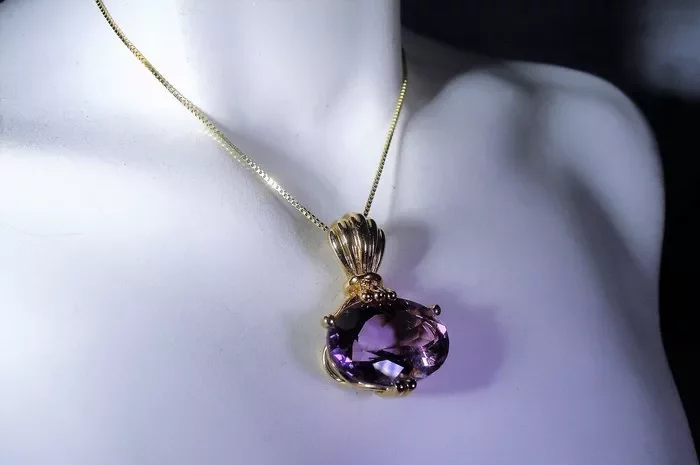Amethyst black gems are a fascinating variety of the semiprecious gemstone amethyst, known for their unique coloration and mystical properties. These gems have captivated collectors and jewelry enthusiasts for centuries, due to their striking appearance and believed healing powers. As a jewelry appraiser, understanding the different types of amethyst black gems is crucial for accurately assessing their value and providing informed advice to clients. This guide will provide a detailed introduction to the types of amethyst black gems, exploring their characteristics, origins, and popular science behind their unique appearance.
Understanding Amethyst
What is Amethyst?
Amethyst is a variety of quartz that displays a rich purple hue, ranging from light lavender to deep violet. This coloration is caused by the presence of trace amounts of iron and other impurities within the quartz crystal structure. Amethyst is a semiprecious gemstone, valued for its beauty and durability, making it a popular choice for jewelry making.
Properties of Amethyst
Amethyst is known for its hardness, ranging from 6.5 to 7 on the Mohs scale, which makes it suitable for use in jewelry. Its transparency and vibrant color make it a versatile gemstone, suitable for a variety of jewelry pieces, including rings, earrings, bracelets, and pendants. Beyond its physical attributes, amethyst is believed to possess mystical and healing properties, making it a favored gemstone in many cultures.
Types of Amethyst Black Gems
Natural Black Amethyst
Natural black amethyst is a rare variety of amethyst that displays a deep, almost black coloration. This coloration is caused by a high concentration of iron and other impurities within the quartz crystal. Natural black amethyst is highly valued for its unique appearance and is often used in high-end jewelry pieces. Due to its rarity, natural black amethyst can be quite expensive, making it a sought-after gemstone for collectors and investors.
Heat-Treated Black Amethyst
Heat-treated black amethyst is a type of amethyst that has been artificially altered to achieve a black coloration. This process involves heating the amethyst to high temperatures, causing the iron impurities within the crystal to react and darken the gemstone. Heat-treated black amethyst is less expensive than natural black amethyst and is more readily available in the market. While some collectors may prefer the natural variety, heat-treated black amethyst offers a similar aesthetic appeal and is often used in jewelry making.
Irradiated Black Amethyst
Irradiated black amethyst is another type of amethyst that has been artificially altered to achieve a black coloration. This process involves exposing the amethyst to radiation, which causes the iron impurities within the crystal to react and darken the gemstone. Irradiated black amethyst is less common than heat-treated black amethyst and is often used in jewelry pieces that require a darker, more intense coloration. Due to the radiation process, irradiated black amethyst may have some health concerns, and it is important to ensure that the gemstone has been properly treated and tested before purchase.
Dyed Black Amethyst
Dyed black amethyst is a type of amethyst that has been artificially colored using dyes or chemicals. This process involves immersing the amethyst in a solution containing the desired dye, which渗透 into the crystal and alters its coloration. Dyed black amethyst is often less expensive than natural or heat-treated black amethyst and is more readily available in the market. However, dyed gems may fade or change color over time, and it is important to ensure that the dye treatment is stable and durable before purchase.
Popular Science Behind Amethyst Black Gems
The unique coloration of amethyst black gems is caused by a combination of factors, including the presence of impurities within the quartz crystal structure and the conditions under which the gemstone forms. The iron impurities within the crystal absorb specific wavelengths of light, causing the gemstone to appear purple or black. The specific coloration of each gemstone depends on the concentration and distribution of these impurities within the crystal.
In addition to their physical attributes, amethyst black gems are believed to possess mystical and healing properties. Many cultures have used amethyst for centuries to promote calmness, reduce stress, and enhance spiritual awareness. The black coloration of some amethyst gems is believed to have additional protective and grounding properties, making them favored by those seeking to balance their energy and promote inner peace.
Conclusion
In conclusion, amethyst black gems are a fascinating variety of the semiprecious gemstone amethyst, known for their unique coloration and mystical properties. Understanding the different types of amethyst black gems, including natural, heat-treated, irradiated, and dyed varieties, is crucial for accurately assessing their value and providing informed advice to clients. Whether you are a collector, investor, or jewelry enthusiast, amethyst black gems offer a beautiful and unique addition to any collection.
Related topic:
- How Much is Green Amethyst Worth?
- What Does Green Amethyst Do?
- What Happens When You Start Wearing Amethyst?


